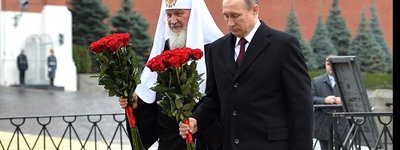Cloister Clash
As Victor Yelensky has suggested elsewhere on this site (Yelensky, “Research and Branding Fake”), there appears to be a campaign to transfer historic church property in Ukraine from the state to the Ukrainian Orthodox Church of the Moscow Patriarchate (UOC-MP). This was the evident object of Draft Law No. 9690, “On Transferring Cultural Heritage Sites to Religious Organizations,” registered in parliament last January 18 by Andrii Derkach of the ruling Party of Regions. Shortly after the bill was registered, Minister of Culture Mykhailo Kulyniak fired the director of the Kyiv Caves Monastery National Historical and Cultural Reserve along with the directors of other state-owned religious complexes. The new director at the Caves Monastery complex is Viktoria Lisnycha, 33, a cardiologist with a law degree, who has served as deputy minister of culture for museums. (Zenon Zawada, “New Bill Calls for Transfer of Religious Sites to UOC-MP,” The Ukrainian Weekly, March 11, 2012, pp. 1, 5). Some see the personnel turnover as a prelude to “privatization” of historic church properties.
In principle, traditionally Orthodox church buildings could be transferred to any of Ukraine’s three Orthodox Churches. But in practice only the UOC-MP is likely to benefit. Many see this as a dangerous concession to a Church which, after all, is tied to a foreign center often hostile to Ukrainian interests and closely tied to the Putin regime. Consequently, a number of bills were submitted in the Rada by opposition leaders to place a moratorium on state transfers of church property to the Churches, such as draft laws No. 9690-1 (Oleksander Yavorivsky, BYuT) and No. 9087 (Olga Bodnar, BYuT).
Among the sites covered by these laws would be the eleventh-century Kyiv Caves Lavra Monastery, the sixteenth-century (or possibly thirteenth-century) Pochaiv Lavra Monastery, and the seventeenth-century Theophany Monastery in Kremenets’. (A lavra is a monastic institution independent of the local bishop and subject to the direct authority of the patriarch or the holy synod.) All three are controlled by the UOC-MP, though it owns only a part of the Kyiv Caves complex.
Among ecclesiastical properties, monasteries present special problems. Unlike churches, they are inhabited. Hence, they cannot be shared by different confessions holding alternating services. Transferring a monastery to a different church organization would mean displacing its residents. Furthermore, these particular monasteries have venerable histories.
According to the Primary Chronicle, St. Anthony of the Caves founded the Caves Monastery in Kyiv in 1051. It remained a monastery for nearly nine hundred years. Major additions and renovations took place during the Ukrainian Orthodox revival in the seventeenth and early eighteenth centuries. In September 1926, the Bolshevik regime transformed it into the “Kyiv Caves State Historical-Cultural Reserve,” consisting of about a hundred structures on twenty-eight hectares of land. Four museums were created on the premises. (“The State Historical and Cultural Museum of Kiev-Pechersk Lavra,” Kyiv: Mystetstvo, 1990). Around the time of the Millennium of the Baptism of Rus’ in 1988, during the Gorbachev reforms, the Ukrainian SSR turned over the Far Caves complex with adjacent churches and other buildings to the Russian Orthodox Church.The Church has made efforts to expel various non-religious entities from the reserve.
According to legend, the Pochaiv Dormition Lavra Monastery was founded in the wake of the Mongol incursion of 1240. The cathedral church houses a miraculous icon of the Mother of God, who is said to have appeared on Pochaiv hill in 1340. There is also a rock with what is said to be her footprint (Polnyi pravoslavnyi bogoslovskii entsyklopedicheskii slovar’ [PPBES], St. Petersburg, reprint 1992, vol. II, p. 1870). According to another legend, the Mother of God saved the monastery from a Turkish attack in the seventeenth century. The remains of the revered hegumen Job of Pochaiv, who died in 1651, are kept in the cave church (PPBES, vol. I, p. 1106). The monastery was held by the Uniate Basilians between 1713 and 1831(on which basis the Basilian order made a claim for the property on March 3, 2012). In 1832 it was turned over to the Russian Orthodox Church. Around the end of the nineteenth century it housed 139 monks (PPBES vol. II, p. 1870). It has long been a popular pilgrimage site for all of Russia (and before the First World War, even for Greek-Catholics from across the nearby Austrian border). In the 1920s and 1930s, when the region was part of the Second Polish Republic, Pochaiv became a center of pro-Russian sentiment during the struggle between Russian and Ukrainian elements in Poland’s Orthodox Church.
From 1961 to 1966, during the last years of Premier Nikita S. Khrushchev’s anti-religious campaign and the first years of the Brezhnev era, the monastery was the object of severeadministrative and economic persecution. Monks were beaten and in some cases killed by the police, while pilgrims were maltreated and, in one notorious case, raped and murdered. The apparent reason was the importance of Pochaiv as a pilgrimage site where genuine, informal discussion and exchange of information among and between laity and clergy could take place. Despite an international outcry, persecution continued sporadically into the 1980s (Dimitry Pospielovsky, The Russian Church under the Soviet Regime 1917-1982, vol. II, pp. 343-346, 442-444).
The Theophany Monastery in Kremenets’ (Volhynia) was founded in 1636 as a Uniate monastery. With the liquidation of the Union in this area in 1839, it became Orthodox. At the end of the nineteenth century, it had three churches and a school, and accommodated thirty-one monks (vol. II, p. 1486).
There are two problems with keeping these properties in state hands. First of all, general principles and European Union policy hold that ecclesiastical properties ought to belong to churches. Second, a hostile regime could take advantage of state ownership of church properties to the detriment of the churches and of religion itself.
Is there no alternative, then, to state ownership or ownership by the UOC-MP? One could argue that the major monasteries ought to be divided among Ukraine’s three Orthodox churches: for example, the UOC-MP could keep the Kyiv Caves Monastery, the UOC-Kyiv Patriarchate could get Pochaiv, while the Ukrainian Autocephalous Orthodox Church might receive the Theophany Monastery in Kremenets’. But monks would have to be displaced. And such an arbitrary approach would satisfy no one.
Another solution would be to create a trust to hold these and other major church properties until certain conditions were met by the interested Churches. The trustees could include Ukrainian and foreign experts on church preservation, art and architecture, canon and civil law, history and theology as well as representatives of the Orthodox Churches. The trust instrument could specify that the trust would end once Ukraine’s Orthodox Churches recognized each other or entered into communion, or even united into a single autocephalous Church directly under the Ecumenical Patriarchate. Once these conditions were fulfilled, the trustees would distribute the trust property,including these three monasteries, to the trust beneficiaries – the Orthodox faithful of Ukraine.










